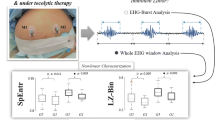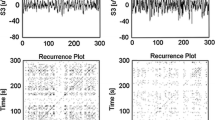Abstract
Objective
To use artificial neural networks (ANNs) on uterine electromyography (EMG) data to classify term/preterm labor/non-labor pregnant patients.
Materials And Methods
A total of 134 term and 51 preterm women (all ultimately delivered spontaneously) were included. Uterine EMG was measured trans-abdominally using surface electrodes. “Bursts” of elevated uterine EMG, corresponding to uterine contractions, were quantified by finding the means and/or standard deviations of the power spectrum (PS) peak frequency, burst duration, number of bursts per unit time, and total burst activity. Measurement-to-delivery (MTD) time was noted for each patient. Term and preterm patient groups were sub-divided, resulting in the following categories: [term-laboring (TL): n = 75; preterm-laboring (PTL): n = 13] and [term-non-laboring (TN): n = 59; preterm-non-laboring (PTN): n = 38], with labor assessed using clinical determinations. ANN was then used on the calculated uterine EMG data to algorithmically and objectively classify patients into labor and non-labor. The percent of correctly categorized patients was found. Comparison between ANN-sorted groups was then performed using Student’s t test (with p < 0.05 significant).
Results
In total, 59/75 (79%) of TL patients, 12/13 (92%) of PTL patients, 51/59 (86%) of TN patients, and 27/38 (71%) of PTN patients were correctly classified.
Conclusion
ANNs, used with uterine EMG data, can effectively classify term/preterm labor/non-labor patients.







Similar content being viewed by others
References
Buhimschi C., Boyle M. B., Saade G. R., Garfield R. E. (1998) Uterine activity during pregnancy and labor assessed by simultaneous recordings from the myometrium and abdominal surface in the rat. Am. J. Obstet. Gynecol. 178:811–822
Devedeux D., Marque C., Mansour S., Germain G., Duchene J. (1993) Uterine electromyography: A critical review. Am. J. Obstet. Gynecol. 169:1636–1653
Diaz C., Conde J. E., Estevez D., Olivero S. J. P., Trujillo J. P. P. (2003) Application of multivariate analysis and artificial neural networks for the differentiation of red wines from the Canary Islands according to the island of origin. J. Agric. Food Chem. 51(15):4303–4307
Fausett, L. Fundamentals of Neural Networks, Prentice-Hall, 1994
Figueroa J. P., Honnebier M. B., Jenkins S., Nathanielsz P. W. (1990) Alteration of 24-hour rhythms in the myometrial activity in the chronically catheterized pregnant rhesus monkey after 6-hours shift in the light-dark cycle. Am. J. Obstet. Gynecol. 163:648–654
Garfield, R. E., K. Chwalisz, L. Shi, G. Olson , and G. R. Saade, Instrumentation for the diagnosis of term and preterm labour. J. Perinat. Med. 26:413–436, 1998 (Review)
Garfield R. E., Maner W. L., MacKay L. B., Schlembach D., Saade G. R. (2005) Comparing uterine electromyography activity of antepartum patients versus term labor patients. Am. J. Obstet. Gynecol. 193(1):23–29
Garfield, R. E, W. L. Maner, H. Maul, and G. R. Saade. Use of uterine EMG and cervical LIF in monitoring pregnant patients. BJOG 112(Suppl 1):103–108, 2005
Garfield R. E., Saade G., Buhimschi C., Buhimschi I., Shi L., Shi S. Q., Chwalisz K. (1998) Control and assessment of the uterus and cervix during pregnancy and labour. Hum. Reprod. Update 4:673–695
Glass J. O., Reddick W. E., Goloubeva O., Yo V., Steen R. G. (2000) Hybrid artificial neural network segmentation of precise and accurate inversion recovery (PAIR) images from normal human brain. Magn. Reson. Imaging 18(10):1245–1253
Gurney, K. An Introduction to Neural Networks, UCL Press, 1997
Haykin, S. (1999) Neural Networks 2nd ed. Prentice Hall, ISBN 0 13 273350 1
Iams J. D. (2003) Prediction and early detection of pre-term labor. Obstet. Gynecol. 101:402–412
Karlsson J. S., Gerdle B., Akay M. (2001) Analyzing surface myoelectric signals recorded during isokinetic contractions. IEEE Eng. Med. Biol. Mag. 20(6):97–105
Kohonen, T. “Self organizing maps”, In: Springer Series in Information Sciences, edited by T. Kohonen, T. S. Huang, and M. R. Schroeder. Heidelberg: Springer, 2005
Kuriyama H., Csapo A. (1967) A study of the parturient uterus with the microelectrode technique. Endocrinology 80:748–753
Lammers W. J.,Stephen B.,Hamid R.,Harron D. W. (1999) The effects of oxytocin on the pattern of electrical propagation in the isolated pregnant uterus of the rat. Pflugers Arch. 437(3):363–370
Lawrence J. (1991) Data preparation for a neural network. AI Expert. 11:34–41
Linhart J., Olson G., Goodrum L., Rowe T., Saade G., Hankins G. (1990) Preterm labor at 32 to 34 weeks’ gestation: effect of a policy of expectant management on length of gestation. Am. J. Obstet. Gynecol. 178:S179
Lockwood CJ., Kuczynski E. (2001) Risk stratification and pathological mechanisms in preterm delivery. Paediatr. Perinat. Epidemiol.. 15 (Suppl 2):78–89
MacIsaac D. T., Parker P. A., Scott R. N., Englehart K. B., Duffley C. (2001) Influences of dynamic factors on myoelectric parameters. IEEE Eng. Med. Biol. Mag.. 20(6):82–89
Maner W. L., Garfield R. E., Maul H., Olson G., Saade G. (2003) Predicting term and preterm delivery with trans-abdominal uterine electromyography. Obstet. Gynecol. 101(6):1254–1260
Maner W. L., MacKay L. B., Saade G. R., Garfield R. E. (2006) Characterization of abdominally acquired uterine electrical signals in humans, using a non-linear analytic method .Med. Biol. Eng. Comput. 44(1–2):117–123
Marshall J.M. (1962) Regulation of the activity in uterine muscle. Physiol. Rev. 42:213–227
Maul H., Maner W. L., Olson G., Saade G. R., Garfield R. E. (2004) Non-invasive trans-abdominal uterine electromyography correlates with the strength of intrauterine pressure and is predictive of labor and delivery. J. Matern. Fetal Neonatal. Med. 15(5):297–301
Nagarajan R., Eswaran H., Wilson J. D., Murphy P., Lowery C., Preissl H. (2003) Analysis of uterine contractions: a dynamical approach. J. Matern. Fetal Neonatal. Med. 14(1):8–21
U.S. Preventive Services Task Force. Guide to Clinical Preventive Services: An Assessment of the Effectiveness of 169 Interventions. Williams & Wilkins, Baltimore, 1989
Wolfs G. M. J. A. (1979) Van Leeuwen. Electromyographic observations on the human uterus during labor. Acta Obstet. Gynecol. Scand. Suppl. 90:1–61
Wyns B., Sette S., Boullart L., Baeten D., Hoffman I. E., De Keyser F. (2004) Prediction of diagnosis in patients with early arthritis using a combined Kohonen mapping and instance-based evaluation criterion. Artif. Intell. Med. 31(1):45–55
Acknowlegment
We would like to thank NIH (R01-HD037480) for the funding to complete this research.
Author information
Authors and Affiliations
Corresponding author
Rights and permissions
About this article
Cite this article
Maner, W.L., Garfield, R.E. Identification of Human Term and Preterm Labor using Artificial Neural Networks on Uterine Electromyography Data. Ann Biomed Eng 35, 465–473 (2007). https://doi.org/10.1007/s10439-006-9248-8
Received:
Accepted:
Published:
Issue Date:
DOI: https://doi.org/10.1007/s10439-006-9248-8




